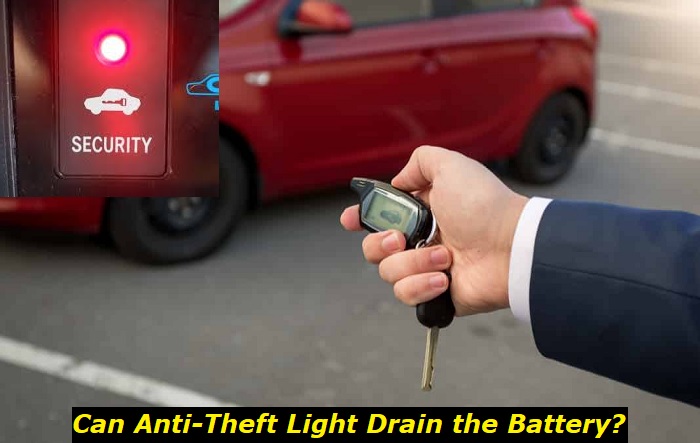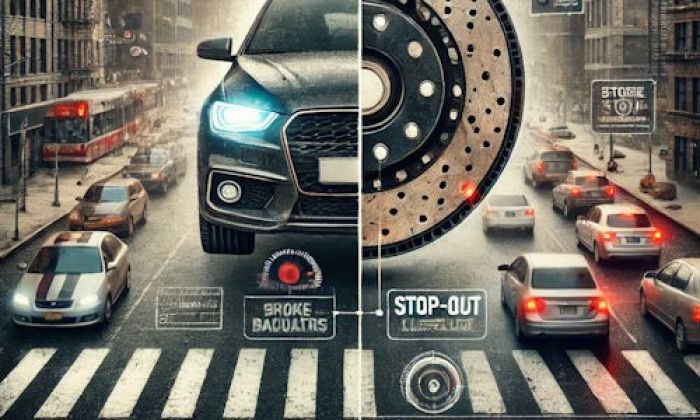Securing your car and other possessions is paramount in an insecure world. More so if you live or work in dangerous neighborhoods. As such, car manufacturers have built anti-theft systems into cars to help owners protect their vehicles. A key sign that your car has an anti-theft system is the presence of an anti-theft light indicator.
Battery drains highlights
- Level of importance:high
- Methods to locate:disconnect everything that can cause drains
- Consequences:dead battery
- Prevention:driving style adjustment, no extra equipment
- DIY fixes:possible but complicated
- Price to fix:$100 - $600

Anti-Theft Light: Function and Relevance
The anti-theft light or immobilizer warning light indicates the presence of an anti-theft system in your car. Most modern vehicles have built-in anti-theft or immobilizer systems. However, there are aftermarket security systems, which are even more complex and offer extra features. This article focuses on built-in anti-theft systems and light indicators.
The purpose of the anti-theft system is to prevent your automobile from getting stolen. Further, depending on the model of your vehicle, some anti-theft systems can track the location of a stolen vehicle and even disable it. The anti-theft light lets you know whether the anti-theft system is active or has some issues. Although different manufacturers implement the anti-theft system in their way, there are similarities in how they work. Please consult your manual for specifics about your car.
Anti-theft systems use a unique ignition key, an Instrument Panel Cluster (IPC), and the Engine Control Module (ECM) to secure your vehicle. The transponder embedded in the ignition key sends a signal to the steering column transceiver if someone attempts to start the car. Following this, the ECM compares the received signal to the set Ignition Key Identification Code (IKIC) that it already holds.
The vehicle will function as expected in the event the IKIC matches the received signal. In contrast, if the IKIC does not match the received signal, the immobilizer system triggers an alarm and prevents the engine from starting. This will continue until the ECM detects a correct IKIC or until a programmed time passes.
Since the anti-theft system is present, you might wonder why you need a light to indicate the fact. It's simple, without the anti-theft light, there is no obvious way to determine if the system is securing your car. Your anti-theft system is active if the anti-theft light blinks when the engine is off. Also, If the anti-theft light is flashing when you start your car, and the engine does not ignite, you might be using the wrong key.
If the anti-theft system is inactive or malfunctioning, the anti-theft lights indicate this to you. Your anti-theft system might be faulty if:
- The anti-theft light stays on after starting the engine.
- The anti-theft light flashes when you start your car with the correct key, and the engine does not ignite. The system might have failed to recognize your key or keyless entry signal.
- The anti-theft light is permanently on rather than blinking when the engine is off.
You will need to get such problems diagnosed and fixed by a professional to ensure the security of your car.
Can The Anti-Theft Light Drain Your Battery?
It is "improbable" that the anti-theft light will drain your car's battery. The anti-theft lights used in most cars today use power-saving Light Emitting Diodes (LED) that consume very little power. The anti-theft LED light consumes between 5 and 10 milliamperes (mAh) when it is on and around 2 to 2.5 milliamperes when blinking. That is not enough power draw to drain a good battery.
Regardless, the anti-theft light's small effect on your battery will be eliminated while the engine is on. The alternator in modern automobiles recharges car batteries while the engine is running.
Many things can drain your car's battery fast, and the anti-theft light indicator is not one of them. Some of the things that can run down your battery quickly include:
- Leaving electrical devices or lights like your headlamp, hazard lights, trunk lights, interior car lights, etc., on while the engine is off
- Faulty alternator
- An old or worn-out battery
- Extreme weather conditions
- Parasitic drain
- Corroded or loose battery terminals
Will The Anti-Theft Light Drain Your Battery If You Leave Your Car for A Long Time?
Now, you might be wondering if, over a longer duration, the anti-theft light will drain your battery. On its own, the anti-theft light will not drain your car's battery life over a very long period.
Most modern vehicles have many features that use the battery to maintain specific processes and operations. Additionally, certain electrical components draw energy from the battery to store some data/user settings while the vehicle is not in use. For example, when the car is off, the battery still powers the clock, alarm, radio, anti-theft system, and smart key system, among other things.
Besides this, even if the battery is completely disconnected, it will still discharge, albeit on a smaller scale than when connected. Self-discharge in batteries occurs due to chemical reactions within the battery. So, even when the battery is disconnected, chemical reactions within it do not stop. Instead, the chemical reactions continue to happen at a lower level, depleting the stored charge.
In essence, specific electrical components and the self-discharge that occurs in batteries will deplete the charge in the battery over time if the car is idle for an extended period.
Most vehicles with healthy batteries can sit idle for between two weeks and two months before the battery gets drained. Car batteries drain that quickly even when the car is not in use because, as already explained, the battery remains in service even when the engine is off.
However, there are cases where the battery gets drained faster than expected, even with electrical components turned off. In such cases, you can discover the cause of this drain with a parasitic draw test. You will need a digital multimeter to perform this test.
Connect the multimeter to the negative terminal of your car's battery. Then, remove the fuses in your car's fuse box, one at a time, and check for changes in the multimeter's reading. After you identify the cause of the drain, the next step is to fix the issue.
The previous paragraph summarizes the parasitic draw test; the process is more complex. Further, you might not have the necessary tools to test and repair parasitic battery drains. So, please consult your local mechanic about any abnormal battery drain issues to get them diagnosed and resolved.
How To Prevent Battery Drain When Leaving Your Car for A Long Time
If you are expecting to leave your vehicle without use for a long time, there are some things you can do to prevent or slow down the battery drain for that period.
1. Get Someone Else to Use Your Car
If you are away from your car for a couple of weeks, you can maintain the charge of your car's battery by letting someone else use it during that time. Alternatively, you can get someone else to warm up your car regularly. You can recruit family members, friends, or neighbors to help you. Allowing the car's engine to run for 15 - 20 minutes daily will allow the alternator to charge up the battery and slow down the drain.
2. Disconnect and Store the Battery
Suppose you do not have anyone to help you while you are away from your car for an extended period. In that case, your most practical option is to disconnect the battery. Electrical components in the car will drain the battery if it is connected. These components rely on the battery to operate when the engine is off. Thus, disconnecting the battery prevents those components from using it and reduces the rate at which it runs down.
Storing your battery in a cool, dry place is advisable to reduce the discharge rate further when disconnected. For example, a room or space with temperatures between 10 and 25°C would be ideal.
3. Use a Battery Maintainer
Now if you do not want to remove the battery from the car, you can use a battery maintainer. A battery maintainer charges your battery as it drains by sending small amounts of energy. The maintainer stops functioning after recharging the battery to its capacity. Also, suppose the charge in the battery drops below a certain level. In that case, the battery maintainer gets re-activated and recharges it.
If you follow this route, ensure you get a battery maintainer that uses the same voltage as your car's battery.
Conclusion
While battery drain ought to be prevented, the anti-theft light in your car is unlikely to cause it in the short or long term. It would help if you kept an eye out for other things more likely to cause battery drain. For example, turn off all electrical components that don't need to run when the engine is not running.
Furthermore, if you will be leaving your car for an extended time, we have outlined some things you can do to prevent battery drain. If you are experiencing abnormal or parasitic battery drain, consult an authorized dealer or automobile mechanic near you for help.
About the authors
The CarAraC research team is composed of seasoned auto mechanics and automotive industry professionals, including individuals with advanced degrees and certifications in their field. Our team members boast prestigious credentials, reflecting their extensive knowledge and skills. These qualifications include: IMI: Institute of the Motor Industry, ASE-Certified Master Automobile Technicians; Coventry University, Graduate of MA in Automotive Journalism; Politecnico di Torino, Italy, MS Automotive Engineering; Ss. Cyril and Methodius University in Skopje, Mechanical University in Skopje; TOC Automotive College; DHA Suffa University, Department of Mechanical Engineering






Add comment